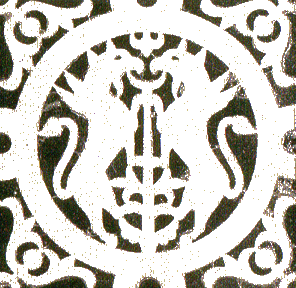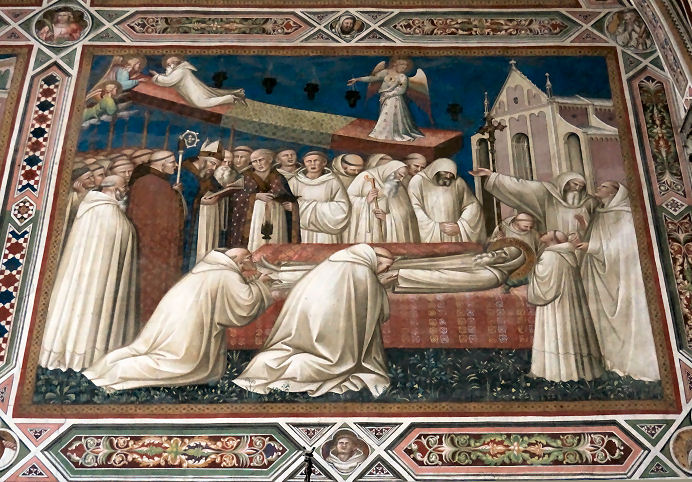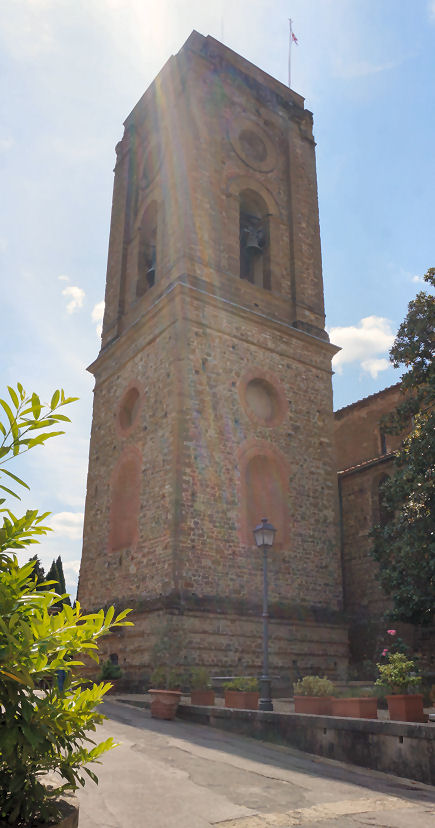|
|
|
San Miniato al Monte Viale Galileo Galilei |
||
 History HistoryFlorence's oldest surviving church after the Baptistery, and like it Tuscan Romanesque in style, San Miniato was built from 1028 to 1063 by Hildebrand, Bishop of Florence, on the site of a chapel protecting the tomb of Saint Minias which had been here since at least the 8th century. Minias is said to have been an Armenian prince serving in the Roman army who refused to sacrifice to the Roman gods. He was martyred by decapitation down in the Piazza della Signoria in 250 and he is said to have carried his decapitated head up to this site following his execution. His relics are kept in the crypt here. The Cluniac Benedictine monastery was given to the Olivetan Bendictines by Gregory XI in 1373. The complex was used as a barracks and fortress by Grand Duke Cosimo I, due to its commanding position, then in 1630 as a plague hospital, and later as a poorhouse. In 1703 Cosimo III gave the monastery to the Jesuits, who remained here officially until Clement XIV suppressed them in 1774. But they remained secretly, protected by Florentine aristocratic supporters. The Olivetans returned in 1784, until the Napoleonic suppressions of 1808. In 1924 they came back yet again and remain here, also looking after the church. The church The sectional façade was begun around 1090, made with white and green marble in geometric patterns, arguably inspired by Arabic decoration. The flattened-arcading effect at ground level is suggestive of a narthex, maybe. The 13th century mosaic panel depicts Christ Between the Virgin and San Miniato and was remade in 1861. High up over the blind arches in the tympanum are square panels which repeat designs from the floor inside. The eagle with outstretched wings clutching a bale of cloth on the very top is the symbol of the cloth importers guild (the Arte di Calamila) who had been responsible for the church's upkeep since 1288. Interior San Miniato is special, in the same way that the Miracoli church in Venice is special, only it's that much bigger, and has frescos. The nave is separated from the aisles by marble columns with various capitals - each side consisting of three pairs separated by a pair of compound piers with half shafts supporting the stout diaphragm arches over the nave. The columns towards the east end are visibly too big for their capitals, these being spolia, recycled from much earlier Roman temples in Florence. Towards the west they do fit, so are probably contemporary. The floor and upper part of the nave is all clad in marble, with a timber ceiling of 1322 that's colourfully decorated. The floor is from 1207 and of opus sectile, looking like a made-of-marble carpet. The clerestory-level decoration, which is painted in imitation of marble, dates from the 19th century, when the roof and polychromatic ceiling was restored. There is a raised choir over a crypt, with a tabernacle in front of it. The tabernacle, the Capella del Crocefisso, was built to house the miraculous Crucifix which was said to have bowed to San Giovanni Gualberto - this Crucifix has been in Santa Trìnita since 1671, and its story is told on that church's page. The tabernacle here was built for Piero il Gottoso Medici (Piero the Gouty) in 1448, around the same time as he was having the larger and more ornate tabernacle built to house the similarly miraculous image at SS Annunziata. Pagno di Lapo Portigiani and Michelozzo were involved in both projects, with Luca della Robbia working on ceiling panels of this one. The controlling Calimala guild (the guild of cloth finishers and merchants) were initially resistant to allowing Piero to add his family and personal arms to the decoration of the tabernacle. But they gave in. Michelozzo's gilded bronze eagle of the Calimala guild, clutching a bale of cloth, dominates the front face, but you'll also find Piero's falcon, his symbol of a diamond ring encircling three feathers and the Medici family palle. The painted panels at the back, which protect the Crucifix, are the work of Agnolo Gaddi (1394-96) and show scenes from the lives of Saints Miniato and Giovanni Gualberto, the Annunciation, and the Passion of Christ. They were originally arranged in a cruciform shape to protect the crucifix.  The left-hand aisle wall begins with two detached frescoes by Mariotto di Nardo (a Virgin and Child with Saints and a Crucifixion with Seven Saints) and a damaged but admirable anonymous Crucifix (see right). Here is also the projecting (as you can see on the plan at the top of the page) Chapel of the Cardinal of Portugal Built 1460-68 to plans by Antonio Manetti, a pupil and biographer of Brunelleschi, but with the work done by Bernardo Rossellino, the older brother of Antonio, the sculptor of the tomb here. Cardinal Jaime of Lusitania, the nephew of King Alfonso V of Portugal, died of fever on route from Rome to Austria on the 27th August 1459 at the age of 25. Amongst his last words, according to the Florentine bookseller Vespasiano da Bisticci, was a request he be buried in San Miniato. His aunt, the Duchess Isabella of Burgundy, the wife of Philip the Good, and his humanist friends funded the chapel, the only one in the church apart from the saint's. It was created by knocking a hole in the wall and building the chapel, square like a classical mausoleum. The tomb itself, to the right, is by Antonio Rossellino and is his masterpiece. To the left of the tomb. opposite the chapel's entrance is the altar with an altarpiece showing three standing saints - Saint James, the cardinal's name saint, who gazes out at the cardinal's tomb, flanked by Saints Vincent (the patron saint of Portugal) and Eustace. The paintings in here are all hard to see though, due to dinginess, and this altarpiece is a copy, the original, painted before 1466 by Antonio and Piero del Pollaiuolo, being now in the Uffizi, having been moved there in March 1799 because of concerns for its deteriorating condition. Its Netherlandish plushness, particularly in the fabrics, is said to be down to its commissioning Portuguese clients having family connections to the Burgundian court. It was even painted on Netherlandish Baltic oak panels (as was Baldovinetti's Annunciation) rather than the usual Italian poplar, using oil paints. The back wall above the altarpiece is frescoed, also by the Pollaiuolo brothers, with angels pulling aside a curtain, echoing the angels and curtains above the tomb. The much-damaged Annunciation on the left wall, above the marble bishop's throne, and the Evangelists and Doctors of the Church frescoed in the lunettes and spandrels are by Alesso Baldovinetti. Oddly The Annunciation is painted on two unprepared oak panels, but the sky and trees above are frescoed onto the wall. The five glazed terracotta medallions in the dome were made in 1462 by Luca della Robbia, echoing the design of the cosmatesque floor. They depict the four cardinal virtues and the dove of the apocalypse, set into a field of illusionistic boxes. Climbing the steps to the pontilo over the crypt gives you a good view of the oldest frescoes here - an Annunciate Virgin and a Nativity fragment from the late 13th century. As you cross you can admire the lovely marble work on the screen and pulpit, by Giovanni and Francesco di Domenico in 1466, and the apse (see right) (there's a light switch at the top of the right-hand steps) containing the 13th-century dome mosaic depicting Christ Between the Virgin and San Miniato and a della Robbia Crucifix. The mostly late-12th-century raised presbytery and screen here is a unique medieval survival. The wooden choir stalls were commissioned from Giovanni di Domenico da Gaiuole and Francesco di Domenico detto Monciatto in 1466. Amongst the intarsia panels are the crown and olives of the Olivetans and the coat of arms of the Arte di Calimala. In the right hand corner up here is the entrance to The Sacristy, with fittings and frescos commissioned by Benedetto Alberti. Frescoed by Spinello Aretino in 1387-88, with large evangelists in the vault and episodes from the Life of Saint Benedict on the walls, so lots of scenes full of chaps in white robes (see below). Spinello is here very much still influenced by Giotto, who was probably the teacher of Jacopo del Casantino, who in turn (arguably) taught Spinello, but Spinello's figures don't group well. These frescoes have also been somewhat over-restored.  There are some early (13th century) frescoes of saints on the choir wall by the entrance to the sacristy. Returning down the other stairs into the right-hand aisle, here are, nearer the door, a Virgin Enthroned with Six Saints, by Paolo Schiavo from 1436, and a large Saint Christopher of the 14th century. Seeing a Saint Christopher was thought to have offered protection or travellers and against sudden death for that day, so you'll often find big ones visible from church doorways. The crypt (see right) under the raised presbytery is 11th-century, groin-vaulted and has its original altar containing Saint Minias's relics, on the site where Bishop Hildebrand had found them centuries before. The vaults above it are frescoed with saints and prophets, on a blue starry-night background, by Taddeo Gaddi. These very damaged and heavily restored works are from his early maturity (c.1338/41) - later than the Baroncelli Chapel in Santa Croce - but they are all that remains of his work here, probably commissioned by the Corbinelli family, many of whom were prominent wool merchants.  Campanile Unfinished. Built by Baccio d'Agnolo around 1520 as the existing tower had collapsed in 1499. During the siege of 1529, during which it was used as an artillery post, Michelangelo saved it by covering it in woollen mattresses to protect it from the enemy cannon balls. Lost art Three by Agnolo Gaddi painted in the 1380s/90s, towards the end of his career. A Crucifixion, part of the predella of a polyptych, perhaps the one that he painted for here. It's been in the Uffizi since 1860. Secondly an altarpiece of The Virgin and Child with Saints Andrew, Benedict, Bernard, and Catherine of Alexandria with Angels (see right) from c.1388 and painted for the Alberti family for the sacristy here, now in the National Gallery in Washington. Lastly a lovely Coronation of the Virgin in the National Gallery, the original location for which is in doubt, but here looks the most likely place. The church in art Several views exist by two of the Macchiaioli group. La prima bandiera italiana portata a Firenze nel 1859 (The first Italian flag brought to Florence) (1859) (see below) by Francesco Saverio Altamura. And Interno di San Miniato (1861) (see right) by Giuseppe Abbati, one of at least four he painted with similar titles. The church was painted by Fabio Borbottoni in the late 19th century too (see below right), but he calls it the Chiesa delle Porte Sante in the title and adds avanti il restauro. Dante wrote San Miniato is one of only three churches in Florence mentioned by Dante in The Divine Comedy, the other two being the Baptistery and the Badia. In Purgatory Canto 12 he wrote about 'That steep, upon whose brow the chapel stands ... looking lordly down On the well-guided city (the latter description being ironic). and Now we ascended by the sacred stairs, but I seemed to be much more light than I had been, before, along the level terrace. Opening times Winter 7.00 - 1.00 & 3.30 - 7.00 Summer 7.00 - sunset Sundays 8.00 - 7.00 (From 7-8am only the side door is open.) Update October 2025 The church and campanile are covered in scaffolding, but the work is noisily progressing..
|
|
|
 |
||
| The Porte Sante Cemetery | ||
|
The Porte Sante Cemetery was planned from 1837 but work began seriously only after the cholera epidemic of 1854. Santa Croce had become overcrowded and it being the period when Florence was Italy's capital added to the urgency. The original architect was Niccolò Matas, who was also responsible for the façade of Santa Croce. Later, in 1864, Mariano Falcini replaced Matas and his plans involved expansion of the cemetery into the area beyond the 16th-century fortress adjoining the church, the walls of which had been designed by Michelangelo and incorporated in Matas's plan. These plans were not implemented. The monumental entrance was built, in the 1920s, but the planned Pantheon never was, so the graves of the famous are dotted around. Amongst the cemetery's more famous burials are Carlo Collodi, creator of Pinocchio, Franco Zeffirelli, the Florentine film director, and the author Vasco Pratolini. The site initially seems quite small, with not much monumental sculpture and few mausoleums. But once you pass the campanile around the left side of the church the change in scale is massive.
|
|
|
|
Centre
::
East ::
West ::
Oltrarno :: Fiesole
|
||